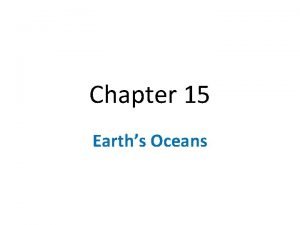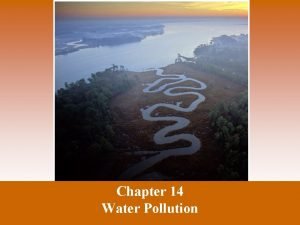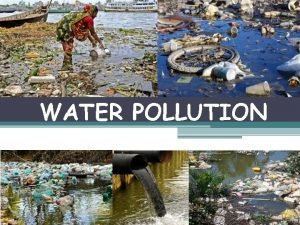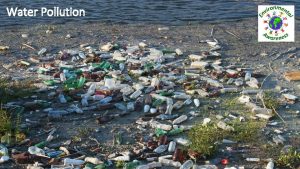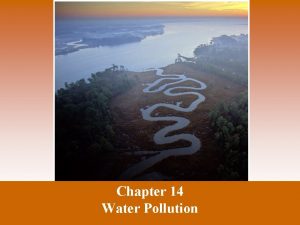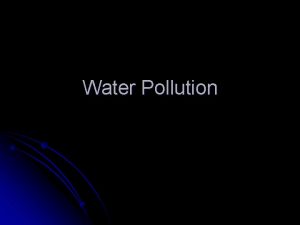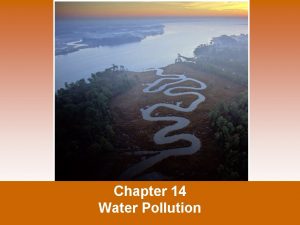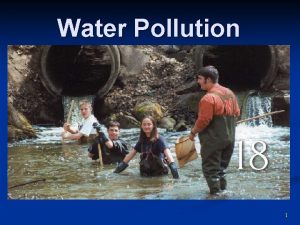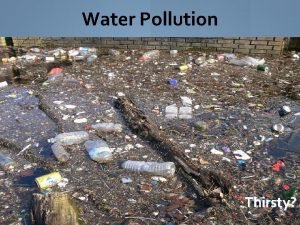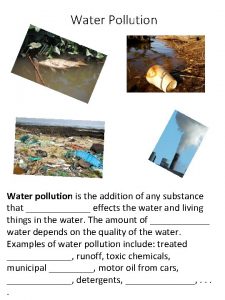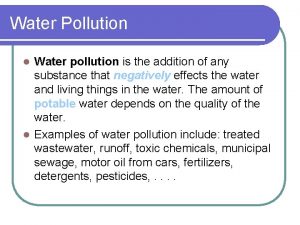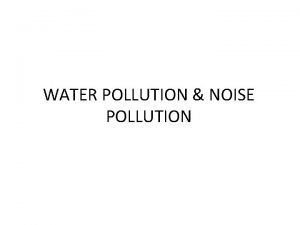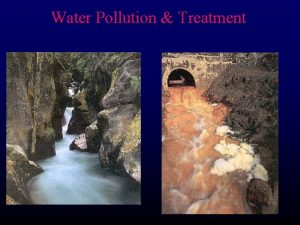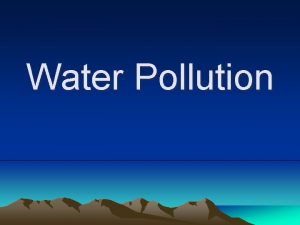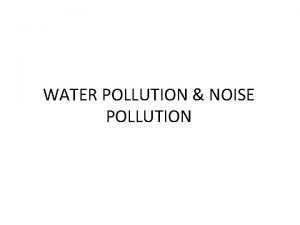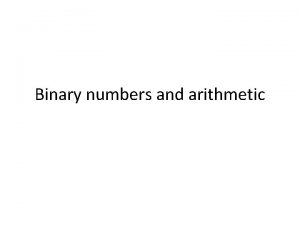WATER POLLUTION Water Pollution is the addition of


























- Slides: 26

WATER POLLUTION

Water Pollution is the addition of any substance that has a negative effect on water or the living things that depend on water. The substances that cause water pollution are called pollutants.

Water Pollution • It is any chemical, biological, or physical change in water quality that has a harmful effect on living organisms or that makes water unsuitable for desired uses.

2 Sources of pollutants 1. ) POINT SOURCES - discharge pollutants at specific locations through drain pipes, ditches, or sewer lines into bodies of surface water. EXAMPLES: - factories - sewage treatment plants - underground mines - oil tankers

Point source pollution Example: A pipe gushing colored water into a river

2. ) NON - POINT SOURCES • Are scattered and diffused. • Can not be traced to any single site of discharge • EXAMPLES: ▫ Acid deposition ▫ Runoff of chemicals into surface water from: Croplands Logged forests Lawns Parking lots . Livestock feedlots. Urban streets. Golf courses

Point and Nonpoint Sources NONPOINT SOURCES Rural homes Cropland Urban streets Animal feedlot Suburban development POINT SOURCES Wastewater treatment plant Factory

Water pollution • Bacteria, Viruses, Protozoa, Parasitic worms • Oxygen demanding substances • Inorganic plant nutrients • Organic chemicals • Sediment or suspended matter • Thermal pollution • Genetic pollution

Biological Magnification Water 0. 000002 ppm Herring gull 124 ppm Phytoplankton 0. 0025 ppm Herring gull eggs 124 ppm Lake trout 4. 83 ppm Zooplankton 0. 123 ppm Rainbow smelt 1. 04 ppm

A very small amount of DDT in water can build up to harmful levels in living things

Pollution of Streams Ø Oxygen sag curve Fig. 20 -5

Pollution of Lakes Ø Eutrophication Discharge of untreated municipal sewage (nitrates and phosphates) Nitrogen compounds produced by cars and factories Discharge of detergents ( phosphates) Discharge of treated municipal sewage (primary and secondary treatment: nitrates and phosphates) Natural runoff (nitrates and phosphates Manure runoff From feedlots (nitrates and Phosphates, ammonia) Runoff from streets, lawns, and construction Lake ecosystem lots (nitrates and nutrient overload phosphates) and breakdown of chemical cycling Dissolving of nitrogen oxides (from internal combustion engines and furnaces) Runoff and erosion (from cultivation, mining, construction, and poor land use) Fig. 22. 7, p. 499

Major Categories of water pollutants 1. ) Infectious agents Examples: - bacteria - parasitic worms - viruses - protozoa Major human sources: - human and animal wastes Harmful effects: - Diseases

2. ) Oxygen-demanding wastes • Examples: ▫ Organic waste such as animal manure and plant debris that can be decomposed by aerobic bacteria. • Major human sources: ▫ Sewage - paper mills ▫ Animal feedlots - food processing facilities • Harmful effects: ▫ Large populations of bacteria decomposing these wastes can degrade water quality by depleting water of dissolved oxygen; causes death of aquatic life

3. ) Inorganic chemicals Examples: - water soluble acids - compounds of toxic metals such as: . Lead. Selenium. Arsenic - salts such as: . Sodium chloride in ocean water. Fluorides found in some soils

Major human sources: - surface runoff - industrial effluents - household cleaners Harmful effects: - can make freshwater unusable for drinking or irrigation - cause skin cancers and crippling spinal and neck damage (Fluorine) - damage the nervous system, liver, and kidneys (Lead and Arsenic) - harm fish and other aquatic life - lower crop yields - accelerate corrosion of metals exposed to such water

4. ) Organic chemicals Examples: - oil - gasoline - plastics - pesticides - cleaning solvents - detergents Major human sources: - industrial effluents - household cleansers - surface runoff from farms and yards Harmful effects: - Can threaten human health by causing nervous damage - reproductive disorders - some cancers - harm fish and wildlife

5. ) Sediments Examples: - soil - silt Major human sources: - land erosion Harmful effects: - can cloud water and reduce photosynthesis - disrupt aquatic food webs - carry pesticides, bacteria, and other harmful substances - settle out and destroy feeding and spawning grounds of fish - clog and fill lakes, artificial reservoirs, stream channels, and harbours

6. ) Radioactive materials Examples: - radioactive isotopes of: . Iodine. Cesium. Radon. Thorium. Uranium Major human sources: - nuclear and coal-burning power plants - mining and processing of uranium and other ores - nuclear weapons production - natural sources Harmful effects: - genetic mutations - birth defects - miscarriages - certain cancers

7. ) Heat (Thermal pollution) Example: - Excessive heat Major human sources: - water cooling of electric power plants - some types of industrial plants Harmful effects: - Lowers dissolved oxygen levels and makes aquatic organisms more vulnerable to diseases - causes thermal shock

8. ) Plant nutrients Examples: - water-soluble compounds containing nitrate and phosphate and ammonium ions Major human sources: - sewage - manure - runoff of agriculture and urban fertilizers Harmful effects: - cause excessive growth of algae - lowers the oxygen-carrying capacity of the blood that can cause “blue-baby syndrome”

Leaking tank Aqui fer Water table Bedr ock Groundwater flow Free gasoline dissolves in Gasoline groundwater leakage plume (dissolved (liquid phase) Migrating vapor phase Contaminant plume moves with the groundwater Water well

Groundwater Pollution: Causes Hazardous waste injection well Coal strip mine runoff Pesticides De-icing road salt Buried gasoline and solvent tank Cesspool Gasoline station septic tank Pumping well Waste lagoon Water pumping well Landfill Accidental spills Sewer Leakage from faulty casing ifer u q Discharge a ter a hw fer s i e u r Confined aquifer f aq d r e e at nfin w o h c Groundwater Un fres d e flow nfin o C

Groundwater Pollution Prevention Ø Monitoring aquifers Ø Strictly regulating hazardous waste disposal Ø Storing hazardous materials above ground

Industry Nitrogen oxides from autos and smokestacks, toxic chemicals, and heavy metals in effluents flow into bays and estuaries. Cities Toxic metals and oil from streets and parking lots pollute waters; Urban sprawl Bacteria and viruses from sewers and septic tanks contaminate shellfish beds Construction sites Sediments are washed into waterways, choking fish and plants, clouding waters, and blocking sunlight. Farms Runoff of pesticides, manure, and fertilizers adds toxins and excess nitrogen and phosphorus. Closed shellfish beds Closed beach Oxygen-depleted zone Red tides Excess nitrogen causes explosive growth of toxicmicroscopic algae, poisoning fish and marine mammals. Toxic sediments Chemicals and toxic metals contaminate shellfish beds, kill spawning fish, and accumulate in the tissues of bottom feeders. Fig. 20 -15 Oxygen-depleted zone Sedimentation and algae overgrowth reduce sunlight, kill beneficial sea grasses, use up oxygen, and degrade habitat. Healthy zone Clear, oxygen-rich waters promote growth of plankton and sea grasses, and support fish. Fig. 21 -10, p. 505

Technological Approach: Using Wetlands to Treat Sewage ( Sewage Treated water Wetland type plants First concrete pool ( Wetland type plants 45 centimeter layer of limestone gravel coated with decomposing bacteria Second concrete pool
 Water and water and water water
Water and water and water water Chapter 15 earth's oceans
Chapter 15 earth's oceans Hình ảnh bộ gõ cơ thể búng tay
Hình ảnh bộ gõ cơ thể búng tay Frameset trong html5
Frameset trong html5 Bổ thể
Bổ thể Tỉ lệ cơ thể trẻ em
Tỉ lệ cơ thể trẻ em Gấu đi như thế nào
Gấu đi như thế nào Chụp phim tư thế worms-breton
Chụp phim tư thế worms-breton Hát lên người ơi
Hát lên người ơi Môn thể thao bắt đầu bằng từ chạy
Môn thể thao bắt đầu bằng từ chạy Thế nào là hệ số cao nhất
Thế nào là hệ số cao nhất Các châu lục và đại dương trên thế giới
Các châu lục và đại dương trên thế giới Công thức tính thế năng
Công thức tính thế năng Trời xanh đây là của chúng ta thể thơ
Trời xanh đây là của chúng ta thể thơ Mật thư anh em như thể tay chân
Mật thư anh em như thể tay chân 101012 bằng
101012 bằng Phản ứng thế ankan
Phản ứng thế ankan Các châu lục và đại dương trên thế giới
Các châu lục và đại dương trên thế giới Thơ thất ngôn tứ tuyệt đường luật
Thơ thất ngôn tứ tuyệt đường luật Quá trình desamine hóa có thể tạo ra
Quá trình desamine hóa có thể tạo ra Một số thể thơ truyền thống
Một số thể thơ truyền thống Cái miệng bé xinh thế chỉ nói điều hay thôi
Cái miệng bé xinh thế chỉ nói điều hay thôi Vẽ hình chiếu vuông góc của vật thể sau
Vẽ hình chiếu vuông góc của vật thể sau Thế nào là sự mỏi cơ
Thế nào là sự mỏi cơ đặc điểm cơ thể của người tối cổ
đặc điểm cơ thể của người tối cổ Thế nào là giọng cùng tên?
Thế nào là giọng cùng tên? Vẽ hình chiếu đứng bằng cạnh của vật thể
Vẽ hình chiếu đứng bằng cạnh của vật thể

